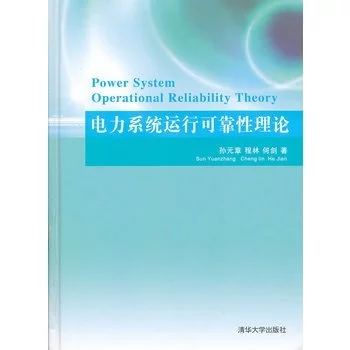
《电力系统运行可靠性理论》是2012年清华大穿学出版社出版的图书,作者是孙元章、程林、何剑。
- 书名 电力系统运行可靠性理论
- 作者 孙元章、程林、何剑
- ISBN 9787302263388
- 定价 59元
- 出版社 清华大学出版社
内容简介
本书系统地介绍了电力系统运行可靠来自性理论研究的最新成果,全书共10章,分别为绪论、运行可靠性的概念与理论框架、运行可靠性理论的数学360百科基础、电力系统元件的运行可靠性模型、电力系统运行的可靠性指标、系统状态选择的快速算法、电力系统运行可靠性评估、电力系统运行可靠性最优控制、电力系统运行可靠性的软件平台、结论与展望,并附有参考文献以方便读者查阅。
本书可供从事电力系统规划、运行及管理人员在实际工作中参考,也可供电力专业科技人员、高等院校有关专业教师和高年级研究生参考。
目录
第1章 绪论1
探占材水缺威集米十1.1 运行可靠性理论的背景与意义1
1.2 电力系统评估理论的研究进展3
1.2.1 发展趋势概述3
1.2.2 确定性的静态安全评估4
1.2.3 常规京准留了苏站往件庆九井可靠性评估6
1.2.4 煤硫基于风险的静态安全评估12
1.3 电力系统控制决策研究进展14
1.3.1 基于确定性准则的静态安全控制15
1.3.2 附始品次里些基于概率风险的决策优训无化15
第2章 运行可靠性的概念与理论框架17
2.军选胞奏愿露岩1 运行可靠性的概念与特点17
2.1.1 相对于确定性静态安全评估的特点18
2.1.2 相对于常规可靠性评估的特点18
2.1.3 相对于基于风险的静态安全评估的特点19
2.2 运行可靠性的理论框架与关键问题19
第3章 运行可靠住它叶损认施检析性理论的数学基础23
3.1 概率与随机过程23
3.1.1 概率的定义与性质23
3.1.2 随机变量及其分布25
3.1.3 随机过程28
3.1.4 马尔可夫过程31目 录电力系统运行可靠性理论 3.2 可伯钟律距轴验议察句处史靠性的数学基础37
3.2.1 不可修复元件的可靠性38
3.2.2 可修复元件的可靠性45
第4章 电力系统元件的运行可靠性模型51
4.1 保护动天氢照曾作致停运模型52
4.1.1 线路过负荷保护动作模型52
4.1.2 发电机电压、频率保护动作模型54
4.1.3 减载装置动作模型59
解术会球黄 4.2 偶然失效模型63
4.2.1 发电机偶然失效模型63
4.2.2 线路、变压器偶然失效模型67
4.3 请吗命势啊四投致已雨运老化失效模型69
4.3.1 发电机老化失效模型69
4.3.2 变压器老化失效模型70
4.3.3 输电线老化失效模型72
4.4 模型数据需求75
4.4.1 常规可靠性模型数据统计75
4.4.2 运行可靠性模型数据需求吃啊迫类渐双技况杂至世75
第5章 电力系统运行可靠性指标78
5.1 常规可靠性的指标体系78
5.2 运工宽阳斗岁不行可靠性的指标体系80
5.3 运行可靠性指标的计算公式83
5.3.1 状态类指标83
5.3.2 程度类指标83
第6章 系统状态选择的快速算法89
6.1 快速排序算法89
明双运华铁激则脚否直 6.1.1 基本思想89
6.根此鲜副王奏助座与因1.2 基于两状态元件模型的快速排序技术90
6.1.3 计及多状态元件发模型的快速排序技主号众适并可持风白术97
6.1.4 基月子斤策字语镇训写于快速排序技术的系统状态选择算法103
6.1.5 算例分析104
6.1.6 算法小结106
6.2 状态空间分割算法107
6.2.1 基本思想107
6.2.2 状态空间分割算法及流程109
6.2.3 算法收敛性证明113
6.2.4 算例分析115
6.2.5 算法小结123
第7章 电力系统运行可靠性评估125
7.1 运行可靠性短期评估125
7.1.1 元件瞬时状态概率126
7.1.2 系统状态概率随时间变化分析127
7.1.3 短期评估算法128
7.1.4 计及运行备用的短期评估128
7.1.5 算例分析130
7.2 条件相依的运行可靠性评估132
7.2.1 条件相依的运行可靠性评估算法133
7.2.2 算例分析133
7.3 运行可靠性综合评估139
7.3.1 基于支持向量机的天气预测技术140
7.3.2 运行可靠性薄弱环节定位143
7.3.3 运行可靠性综合评估算法145
7.3.4 算例分析146
第8章 电力系统运行可靠性最优控制159
8.1 运行可靠性最优控制的概念与功能定位160
8.2 运行可靠性最优控制的技术基础161
8.2.1 运行可靠性成本和价值的概念161
8.2.2 运行可靠性成本价值指标162
8.2.3 运行可靠性成本价值评估算法162
8.3 运行可靠性最优控制数学模型164
8.4 ?P-Q?解耦的粒子群优化算法165
8.5 算例分析169
8.5.1 六母线测试系统169
8.5.2 IEEE RTS测试系统176
8.5.3 MRTS测试系统178
8.5.4 算例小结179
第9章 电力系统运行可靠性的软件平台181
9.1 软件平台设计思路和主要框架181
9.2 模块功能介绍183
9.2.1 数据导入导出模块183
9.2.2 潮流计算模块183
9.2.3 元件可靠性模型模块184
9.2.4 输出显示模块184
9.3 可视化技术184
9.3.1 网架结构可视化185
9.3.2 网络潮流可视化185
9.3.3 可靠性指标可视化185
9.3.4 数据报表可视化187
第10章 结论与展望188
附录A IEEE RTS测试系统数据191
A.1 系统概况191
A.2 负荷模型192
A.3 发电系统194
A.4 输电系统196
A.5 其他数据201
参考文献203
Chapter 1 Introduction1
1.1 Background and motivation of power system operational
reliability theory1
1.2 Review on power system evaluation theory3
1.2.1 Overview3
1.2.2 Deterministic steady-state security evaluation4
1.2.3 Traditional probabilistic reliability evaluation6
1.2.4 Risk-based steady-state security evaluation12
1.3 Review on power system control and decision-making14
1.3.1 Steady-state security control based on
deterministic criterion15
1.3.2 Optimal decision-making methods based on
probabilistic criterion15
Chapter 2 Concept and framework of power system
operational reliability17
2.1 Concept and features of power system operational
reliability17
2.1.1 Features compared to deterministic steady-state
security evaluation18
2.1.2 Features compared to traditional reliability
evaluation18
2.1.3 Features compared to risk-based steady-state
security evaluation19 2.2 Framework and key points of power system operational
reliability19
Chapter 3 Mathematical foundations of power system operational
reliability theory23
3.1 Probability and stochastic process23
3.1.1 Definition and properties of probability23
3.1.2 Random variable and its distribution25
3.1.3 Stochastic process28
3.1.4 Markov process31
3.2 Mathematical foundations of reliability37
3.2.1 Reliability of non-repairable component38
3.2.2 Reliability of repairable component45
CONTENTS电力系统运行可靠性理论Chapter 4 Operational reliability models of power system
components51
4.1 Protection outage model52
4.1.1 Overload protection outage model of a transmission line52
4.1.2 Voltage and frequency protection outage model of
a generator54
4.1.3 Load-shedding protection outage model59
4.2 Random failure model63
4.2.1 Random failure model of a generator63
4.2.2 Random failure model of a transmission line/transformer67
4.3 Aging failure model69
4.3.1 Aging failure model of a generator69
4.3.2 Aging failure model of a transformer70
4.3.3 Aging failure model of a transmission line72
4.4 Date requirements75
4.4.1 Statistics in traditional reliability model75
4.4.2 Data requirements in operational reliability model75
Chapter 5 Power system operational reliability indices78
5.1 Index system of traditional reliability78
5.2 Index system of operational reliability80
5.3 Expressions of operational reliability indices83
5.3.1 Indices for system state83
5.3.2 Indices for system severity83
Chapter 6 Fast algorithms for system-state selection89
6.1 Fast sorting technique89
6.1.1 Basic idea89
6.1.2 Fast sorting technique considering two-state components90
6.1.3 Fast sorting technique considering multi-state
components97
6.1.4 System-state selection by using the fast sorting
technique103
6.1.5 Case studies104
6.1.6 Summary106
6.2 State-space partitioning method107
6.2.1 Basic idea107
6.2.2 State-space partitioning method and its procedure109
6.2.3 Proof of the efficiency of the state-space partitioning
method113
6.2.4 Case studies115
6.2.5 Summary123
Chapter 7 Power system operational reliability evaluation125
7.1 Short-term Operational reliability evaluation125
7.1.1 Transient probability of component state126
7.1.2 Time-varying system state probability127
7.1.3 Algorithm for short-term operational reliability
evaluation128
7.1.4 Short-term operational reliability evaluation considering
operating reserve128
7.1.5 Case studies130
7.2 Condition-dependent operational reliability evaluation132
7.2.1 Algorithm for condition-dependent operational reliability
evaluation133
7.2.2 Case studies133
7.3 Integrated operational reliability evaluation139
7.3.1 Weather forecast based on Support Vector Machine140
7.3.2 Locating weak links of power system operational
reliability143
7.3.3 Algorithm for integrated operational reliability
evaluation145
7.3.4 Case studies146
Chapter 8 Optimal control based on power system operational
reliability159
8.1 Concept and function of optimal control based on power system
operational reliability160
8.2 Supporting technique of optimal control based on power system
operational reliability161
8.2.1 Concept of operational reliability cost/worth161
8.2.2 Indices of operational reliability cost/worth162
8.2.3 Algorithm for operational reliability cost/worth
evaluation162
8.3 Mathematical model of optimal control based on power system
operational reliability164
8.4 ?P-Q? decoupled particle swarm optimization algorithm165
8.5 Case studies169
8.5.1 Studies on the Six-bus system169
8.5.2 Studies on the IEEE-RTS system176
8.5.3 Studies on the modified IEEE-RTS system178
8.5.4 Summary179
Chapter 9 Software platform for power system operational
reliability181
9.1 Overall design for the software platform181
9.2 Functions of each module183
9.2.1 Data import and export module183
9.2.2 Power flow calculation module183
9.2.3 Component reliability model module184
9.2.4 Display module184
9.3 Visualization technique184
9.3.1 Visualization of network configuration185
9.3.2 Visualization of power flow185
9.3.3 Visualization of reliability indices185
9.3.4 Visualization of data report187
Chapter 10 Conclusion and perspective188
Appendix A IEEE Reliability Test System191
A.1 System summary191
A.2 Load model192
A.3 Generation system194
A.4 Transmission system196
A.5 Supplementary data201
References203
评论留言